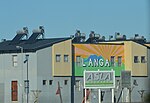Athlone Power Station

Athlone Power Station was a coal-fired power station in Athlone, Cape Town, South Africa. The site stopped generating power in 2003 and is in the process of being decommissioned.Athlone Power Station was situated on the N2 freeway into the city, consisted of a large brick generation building, two 99m brick chimneys, and two cooling towers, fed by reclaimed water from a nearby sewage plant. It was commissioned in 1962 with 6 turbines with a nominal capacity of 180 megawatts, and operated by the City of Cape Town. Between 1985 and 1994 the station was held on standby, but it resumed generating in 1995 with a reduced capacity of 120 MW. Between 1995 and 2003 it was mainly used to generate power in peak demand periods and during power failures of the national grid. In 2003, significant investment was required due to the age of the power station, and generation was stopped.
Excerpt from the Wikipedia article Athlone Power Station (License: CC BY-SA 3.0, Authors, Images).Athlone Power Station
Settlers Way, Cape Town Cape Town Ward 49
Geographical coordinates (GPS) Address Nearby Places Show on map
Geographical coordinates (GPS)
| Latitude | Longitude |
|---|---|
| N -33.948888888889 ° | E 18.513611111111 ° |
Address
Settlers Way
Settlers Way
7455 Cape Town, Cape Town Ward 49
Western Cape, South Africa
Open on Google Maps



